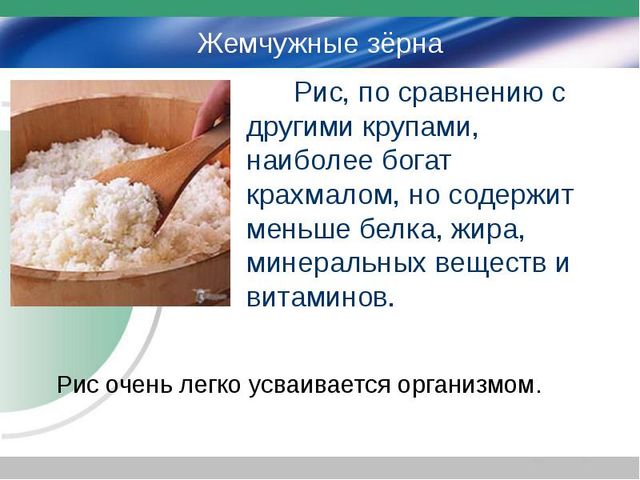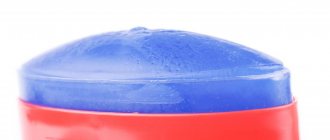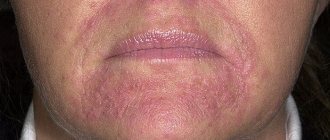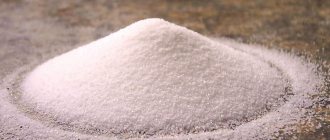Young children are designed in such a way that all their organs and systems begin to function fully only after some time. After birth, the baby needs time to adapt to its new environment.
When breastfeeding with mother's milk, the child's body receives all the vitamins and microelements it currently needs. Since all substances that the mother receives are passed on to the baby through the milk, some elements can cause an allergic reaction in the baby.
Hypersensitivity to substances coming from food is called food allergy, it is manifested by a state of hypersensitivity to any nutrient and the appearance of general and specific signs of allergy. An allergic reaction can develop to a huge amount of nutrients, for example, rice.
Why does an allergic reaction to rice occur?
Most people doubt whether they can be allergic to rice. Despite its widespread consumption, rice contains potentially allergenic substances that can cause negative symptoms in children and adults. We are not talking about gluten intolerance, but about a severe allergic reaction. The following substances contained in rice can cause it: proteins, of which there are more than 10, and proteins.
This condition occurs in adults, and in children it affects up to 5%. An allergy to rice porridge in an infant is a common occurrence, especially if he was previously bottle-fed with a special formula.
Also, the baby may suffer if a nursing mother eats rice in different forms. The allergen enters the baby's body through breast milk. In babies, a reaction to this cereal most often occurs due to the imperfection of their digestive system, with the early introduction of complementary foods, due to individual sensitivity to one or more proteins contained in rice. If one or both parents suffer from a reaction to a grain, the condition may be inherited by the child. The baby may also react to rice pollen.

In adults, the causes of an allergic reaction are similar to those that cause negative symptoms in an infant. They can inherit sensitivity from their parents and acquire it during life. This happens especially often in people who constantly inhale rice dust and come into contact with unprocessed grain during its processing and/or packaging, working in rice fields and in product storage areas.
The reason for the development of negative manifestations may not be the grain itself, but the substances contained in it. These are insecticides, herbicides, pesticides and fertilizers that were used to treat fields when growing cereals or the finished product during storage and transportation. The location of the field also plays a role.
When grown in ecologically clean areas, the risk of developing allergies is much less than when there are various industrial enterprises, large highways or other pollutants in the place of growth.
Purpose of additives in baby food
Why do manufacturers add rice flour or starch to their products? The first thought that comes to mind: the desire to save on fruit and, as a result, on the health of children. Mistrust of additives is also caused by myths about baby food that took shape in the 90s, when puree in jars was a novelty.
But don’t be alarmed: rice flour is not harmful to the baby, and manufacturers use it not only out of a desire to save money.
Fruit and vegetable purees turn out liquid, while meat or poultry purees turn out coarse and uneven. To make a consistency pleasant for the baby, thickeners are used. Remember: homemade pates are also recommended to be flavored, in addition to butter, with regular flour or starch. Rice flour makes liquid puree thicker, and meat food more tender and juicy. This baby food does not drip from the spoon, is easy to scoop and looks appetizing.
Additives in fruit purees are needed for the normal functioning of the child’s digestive tract. They form a film that protects the mucous membranes from the effects of organic fruit acids and reduces the risk of heartburn from apple or pear foods.
The high fructose content in baby puree (for apple and apple-apricot varieties is 60-73 g/l) leads to digestive disorders and is manifested by stomach pain, gas, colic, and diarrhea. After all, the tiny organism has not yet fully formed and cannot digest some foods. Rice flour in baby food helps break down natural sugars into glucose and helps the baby's body absorb nutrients from fruits.
In porridges and milk formulas, this additive is used to give a thick, slightly viscous consistency.
Since rice, unlike other grains, does not contain gluten, using rice flour as a thickener seems to be the right solution. The supplement does not cause allergies (it is hypoallergenic), is suitable for feeding babies with celiac disease and has a positive effect on the children's digestive tract.
Benefits of rice milk for children.
Symptoms
Like other types of allergic reactions, hypersensitivity to rice can cause the following symptoms:
- Numerous hives-like rashes appear on the skin, with an itchy red rash, blistering and severely itchy areas. Children develop atopic dermatitis.
- The mucous membranes become swollen and inflamed. The eyes may become swollen, and allergic conjunctivitis appears.
- From the gastrointestinal tract, abdominal pain, nausea, vomiting, flatulence, loose stools are noted; in infants, the absorption of mother's milk is impaired, frequent regurgitation, restlessness, and foamy stools appear.
- Respiratory disorders are the most dangerous, as they can lead to the development of angioedema and anaphylactic shock, which are potentially life-threatening for the patient. Those suffering from pollen allergies may develop phenomena reminiscent of attacks of bronchial asthma, bronchospasm, rhinitis, and hay fever.
Such manifestations are very dangerous for children under three years of age, especially for infants. Mothers should stop eating grains and extend the breastfeeding period as much as possible.
Composition and effect on infants
Due to its beneficial properties, rice flour is included not only in baby food, but also in the menu of seriously ill adults, whose body is unable to cope with regular food.
80% of the product is carbohydrates, 6% is vegetable proteins with a complete set of amino acids. Flour also contains small amounts of starch, sugars, fiber and fat. Although it cannot compete with fruits in terms of the amount of vitamins, it contains: B1, B2, B4, B5, B6, B9, E.
Children's fruit food without additives is not very rich in microelements necessary for the skin, bones and internal organs of the child.
Rice flour enriches the mineral composition of baby food because it contains:
- magnesium;
- potassium;
- manganese;
- phosphorus;
- zinc;
- selenium;
- iron;
- calcium;
- copper.
Rice flour strengthens the intestines and in large quantities causes constipation. But the same property of the product helps normalize stool in children with diarrhea and intestinal disorders, relieves flatulence and bloating.
At the same time, baby food with rice flour eliminates the development of obesity in young children - it contains practically no fat, but contains protein necessary for the formation of muscle tissue.
The product helps break down complex sugars into glucose. But this property sometimes leads to problems. The child’s body has difficulty coping with large amounts of sugar in the blood, and the baby becomes overly active, noisy, and capricious. Skin rashes are likely to appear.
Therefore, at first, fruit or vegetable purees are given with caution. First, the child is introduced to baby food without rice flour, and only then - with the additive. And they see which food the baby responds to better.
Rice flour has a neutral taste, so it is almost undetectable in baby food. But a large amount makes the puree taste mealy and unpleasant. If you encounter this phenomenon, you are looking at products from an unscrupulous manufacturer.
Rice thickener also makes food lighter. For example, the color of broccoli puree turns from its natural bright green to a pale green.
Hidden allergies (in adults and children)
If an allergy to rice and products with it in an infant usually manifests itself immediately, then in older children and adults the manifestation of a so-called hidden allergy is possible.
It does not appear immediately, but after a long period of eating rice. The reason for its development is the accumulation of antibodies, which provoke numerous manifestations of an allergic reaction. If a child or adult is allergic to rice, then there is a high risk of developing cross-allergy, that is, a reaction to products containing it and to cereals related to rice and even to other products, for example, dairy.
Parents' opinions
Maria, Rubtsovsk. I will not buy food with additives for my child! These are manufacturers trying to save money, but in the end they spoil the health of children. The most important thing is that the children are healthy! I buy “Granny’s Basket”. The only thing: I personally don’t like the smell, but the child willingly eats it.
Elena, Tomsk. Sometimes I give my child food with rice flour, and also with buckwheat or corn flour. Eating without additives makes my daughter’s tummy swell and she goes to the toilet more often. I don’t see anything terrible in rice flour; there is no allergy to sugar.
Natalya, St. Petersburg. Sometimes I buy fruit purees with rice flour when I’m too lazy to feed – without additives it drips heavily from the spoon. Difficult to scoop. For example, “Theme” definitely consists only of water and vegetables - it flows off a spoon.
Is maltodextrin in baby food harmful?
Treatment
To get rid of allergies, you need to do the following:
- Eliminate the allergen, that is, stop eating rice and products containing it completely.
- People suffering from a reaction to rice pollen will have to change jobs or avoid being near this grain in every possible way.
- If the infant reacts, exclude rice from complementary foods and continue breastfeeding.
- Try to reduce the sensitivity of the body by not using products with a tendency to provoke food allergies.
- Take medications prescribed and recommended by your doctor. These can be antihistamines, in severe cases corticosteroids, including in the form of ointments.
- When symptoms appear in the digestive system, sorbents such as activated carbon, Enterosgel, Sorbex and so on, probiotics - Bifiform, Linex - are prescribed.
- Severely itchy areas of the body can be lubricated with Lokoid cream, Fenistil gel, and wiped with alcohol-containing solutions, for example, salicylic alcohol.
- Strengthen your own immunity by hardening yourself, playing sports, walking in the fresh air, swimming, and so on.
You should not self-medicate, especially when it comes to an infant. It is imperative to undergo a full examination, isolate the allergen and undergo treatment prescribed by doctors. Traditional medicine methods can only be used with the consent of the attending physician.
Prevention
Treatment with medications and healing procedures are only half the success. In order for allergies to have minimal manifestations, you need to take care of prevention and strengthening of the body.
The most effective measures:
- Excluding rice from the diet in any form.
- Switch to proper nutrition with an abundance of fruits and vegetables to normalize intestinal function.
- A healthy lifestyle, which includes moderate activity, hardening, and giving up bad habits.
- Mandatory visit to the doctor every six months to monitor the dynamics.
- Carry an antihistamine with you at all times. Rice may unexpectedly turn up in food that is offered at a party or in a cafe. To prevent the situation from getting out of control, the medicine should always be at hand.
How to prevent rice allergies
A child’s allergy to rice and rice porridge can have an extremely negative impact on his health and development, so hypersensitivity is easier to prevent than to cure.
You need to start from the moment of pregnancy. A responsible mother should give up all bad habits and try not to consume potentially allergenic foods during pregnancy. This is of particular importance if the woman herself is allergic, her husband has a reaction, or such cases have been reported in the families of both parents.
The second most important stage is the introduction of complementary foods. It should not be given too early, since the child’s immature digestive system and lack of necessary enzymes will not allow the cereal to be properly digested. This may well lead to the development of a number of negative consequences, including allergies.
When your child reaches three years old, you can try giving him rice using premium quality products. By this age, most children do not show any reaction to such grains.
Adults, especially those suffering from other types and forms of allergic reactions, need to closely monitor their health and how their body perceives new food. It is advisable to avoid artificial foods and various ready-made snacks and canned goods.
For food, you should always choose high-quality rice, obtained from a reputable source, clean, free from impurities and pests. Before cooking, rice must be thoroughly washed to remove not only possible contamination, but also potentially allergenic dust.
Symptoms
The success of treatment of any disease largely depends on the correct diagnosis of the pathology. With allergies, the situation is more complicated, since it is important not only to make an assumption regarding the factors that provoked the external manifestation, but also to identify the main allergen. A negative reaction of the body to rice can be expressed in dermatological changes, problems with the gastrointestinal tract and disorders of the respiratory system. These signs are of a general nature, inherent in all pathologies of a given nature, which further complicates the diagnosis.
Skin manifestations
Exposure to an allergen can lead to dry skin, itching, and rashes on the body in a pinpoint and nodular form. Experts note that the likelihood of hives associated with blistering is not too high. Quincke's edema , accompanied by swelling on the eyelids, lips, cheeks, and in the area of the mucous membranes, is also rare
Typically, the area where itching sensations, increased dryness and flaking appear is small. Patients do not experience serious discomfort. Children may complain of red patches in the anus and genital area. Miliaria and diaper rash are observed.
Gastrointestinal reaction
This is usually how an allergy to rice manifests itself in an infant, although cases can also occur in adult patients. Nausea with vomiting, pain in the abdominal area, flatulence, and changes in stool may occur.

This group of allergens can cause a mild disorder in the form of one-time vomiting or diarrhea in adults. Babies may spit up, have diarrhea or constipation, and have frequent cases of colic. The cause of the disorder is revealed by test data - feces may contain mucus, blood, and tests show a significant presence of eosinophil cells.
Gastritis and enterocolitis are observed within 3 days after the end of interaction with cereals in any form. When you keep rice dishes on the menu, the reaction becomes more intense.
Respiratory problems
The allergen can cause asthma or rhinitis. Such phenomena are quite rare, but cases of runny nose, itching in the nasal canals, frequent sneezing and coughing, and choking are known. The manifestation of congestion occurs abruptly and begins to increase at high speed.
Consumer Reviews
“When this wonderful cream arrived in a package from Proberry, I realized that this cream would suit me one hundred percent. I have very dry and sensitive skin, especially on my hands and face. La-Cri cream is suitable for children and adults, it is very convenient, since our family has small children who simply need a cream without fragrances and dyes. This cream In fact, it softens and moisturizes the skin very well and does not cause allergies or other unpleasant sensations. The cream is absorbed very well. The smell is neutral, not intrusive, just right for small children.”
“La-Cree Cream for dry and sensitive skin suited my very dry facial skin. I especially felt the effect of this cream in winter frosts, when it is -30 outside and there is a blizzard, and meanwhile my face does not tolerate such weather well. Thus, I decided to start applying this cream to my face for 15-20 minutes before going out and after that there was no such harmful effect on my face as without it. It covers the face with a certain invisible layer - a film that protects the face from bad weather. Thus, I decided to purchase a full package of this cream, because one sachet of cream was only enough for me twice.”
- Smirnova G.I. Atopic dermatitis and skin infections in children, Russian pediatric journal, 2014 https://cyberleninka.ru/article/v/atopicheskiy-dermatit-i-infektsii-kozhi-u-detey
- N.L. Rybkina, Modern approaches to newborn skin care: pediatrician tactics, Journal of Modern Clinical Medicine, 2014 https://cyberleninka.ru/article/v/sovremennye-podhody-k-uhodu-za-kozhey-novorozhdennogo-taktika-pediatra
- I.I. Ryumina, V.V. Zubkov, Skin care for a newborn, Healthy Child magazine, 2017 https://cyberleninka.ru/article/v/uhod-za-kozhey-novorozhdennogo-1
Nestlé porridges are popular among parents of young children. They are produced for children of different ages, prepared with or without milk. Additives include fruits, vitamins, and probiotics. But you can be allergic to Nestlé porridge.










